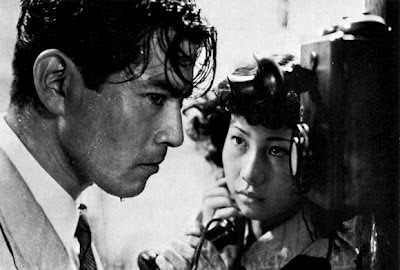This opening sequence does an admirable job of tweaking our expectations, which the rest of the movie shamelessly and systematically rebuilds. The Descendants, which is shot like it was commissioned by the Hawaii Tourism Authority, is a movie about how we're supposed to feel sorry for Matt King (Clooney), a suddenly single father of two who also happens to be a millionaire descended from royalty, and who owns 25,000 acres of unspoiled Hawaiian land. The Descendants is an odious piece of propaganda for the credit default swap era, and a bitter pill made even more indigestible by the fact that, even if you can somehow bracket its ideological assumptions, it still totally fucking sucks.
During filming, this Hawaiian tent city for the homeless was bulldozed to make way for a catering tent.
The film attempts to paper over King's privileged status by subjecting him to the tragedy of having his wife Elizabeth fall into an irreversible coma. As King prepares for her removal from life support, he tries to rebuild a flickering connection with his daughters--caused largely by the fact that he works hard as an attorney, rather than relying on his inherited fortune. King discovers that his wife had cheated on him with a real estate agent (Matthew Lillard) poised to gain a windfall from the sale of his inherited land, which King is preparing to authorize. The film counts down to these two events--Elizabeth's death and the sale of the land--depicting how King tries to prepare for both.
This movie reminded me a lot of the equally overvalued Little Miss Sunshine, in that both seem to pack all of the tedious, spoiled self-importance of contemporary "serious" fiction into a film catering to critics who are incapable of critical thinking. The action here is quintessentially low stakes, as Elizabeth's forthcoming demise is revealed early on and King's assorted anguishes are almost entirely unconvincing. His daughters are rendered in Hollywood high cliche: the rebellious teenager (we know she's rebellious because she swears) and the precious, quirky young thing whose innocence is unspoiled by the weighty goings-on occurring around her. Along for the ride is a doltish and insufferable "surfer dude" buddy long past his 1997 expiration date. (Remember how this movie insisted that it wouldn't deal in cliches at the beginning?)
But the real way that The Descendants tries to get us to care about its dramatically inert storyline is by casting George Clooney as King, which is sort of like casting Ryan Gosling as the lead in a biopic of Lloyd Blankfein. In this way, it's a lot like Juno: try to imagine just about anyone but the chosen actors in the central role, and it quickly becomes apparent how truly awful these movies are. (Picture a Juno starring, say, Meghan Fox, or a Descendants headlined by Ryan Reynolds; no one has the stomach for such a picture.) But Clooney's charisma is also a double-edged sword: even given King's unavailability, it's kind of tough to believe that his wife would cheat on him with Matthew Lillard.
From a deleted scene where Lillard's uptight real estate agent goes rollerblading.
All of this bullshit is designed to camouflage the fact that this is a movie about the trials and tribulations of the upper class, and how they really aren't that different from you and me. Sure, King is a millionaire who owns enough land to shanghai you and everyone you've ever met into slave labor on his sugar plantation, but he just can't connect with his children! And his wife is dying! Surely, such tragedies prove that differences of wealth and class don't divide us as much as we imagine?
There's a couple problems with this picture. Despite the revelation that people in King's tax bracket are not actually immune to death (yet), the fact that his wife fell into a coma thanks to a freak speedboat accident hardly puts her on the same level as people who can't afford treatment when they break their fingers working a double shift at the chicken rendering plant. (Or those who have to give up food in order to fill prescriptions.) The idea that such an unexpected emergency might impose significant financial hardship is, obviously, never even mentioned here; mere mortals may struggle to pay for a visit to the dentist's office, but King naturally can bankroll an extended hospital stay while taking several days off in order to chase Matthew Lillard around Hawaii like a small child in search of Pokemon.
And King's supposed estrangement from his children is similarly muted; the lip service paid to the teenage hellion prone to "drugs and older men" is not really borne out by the sassy-but-supportive waif who follows King around the islands with a harmless, platonic pothead in tow. Along the way, director Alexander Payne's camera roams over the scenery like Larry Clark's over a gaggle of naked teenagers, constantly re-inscribing the idea of Hawaii as a pristine island utopia, despite all assurances to the contrary. There are plenty of Hawaiians for whom this stereotype is glaringly false--but they are conveniently airbrushed out of The Descendants.
Larry Clark's version of The Descendants would've consisted entirely of scenes like this.
I'm sure that there are people out there who will find The Descendants hits close to home; if you've ever worn an ascot or had to fumigate your poolhouse, this movie will no doubt speak to you. But frankly, given George Clooney's apparent passion for social justice, it's disappointing he'd sign on for such a transparent apologia for the 1%. But what is Hollywood really about, if not glaringly obvious lies?























